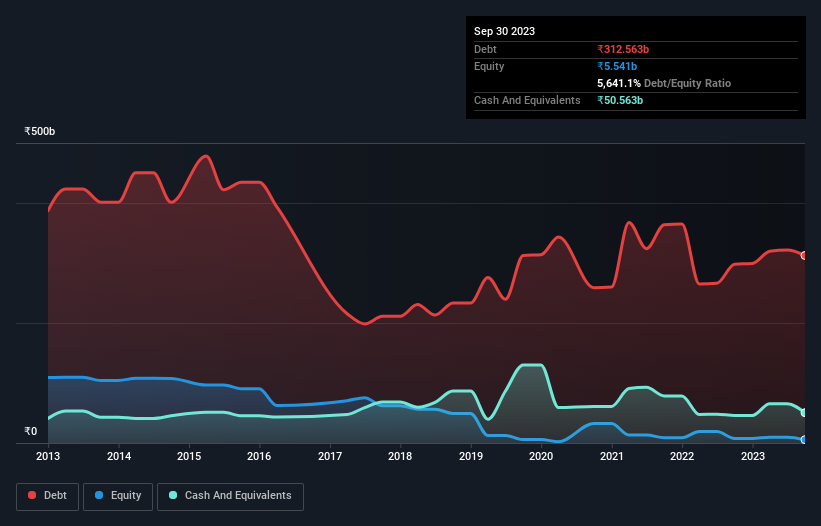- India
- /
- Infrastructure
- /
- NSEI:GMRAIRPORT
Does GMR Airports Infrastructure (NSE:GMRINFRA) Have A Healthy Balance Sheet?

The external fund manager backed by Berkshire Hathaway's Charlie Munger, Li Lu, makes no bones about it when he says 'The biggest investment risk is not the volatility of prices, but whether you will suffer a permanent loss of capital.' So it seems the smart money knows that debt - which is usually involved in bankruptcies - is a very important factor, when you assess how risky a company is. As with many other companies GMR Airports Infrastructure Limited (NSE:GMRINFRA) makes use of debt. But the more important question is: how much risk is that debt creating?
What Risk Does Debt Bring?
Debt and other liabilities become risky for a business when it cannot easily fulfill those obligations, either with free cash flow or by raising capital at an attractive price. Part and parcel of capitalism is the process of 'creative destruction' where failed businesses are mercilessly liquidated by their bankers. However, a more common (but still painful) scenario is that it has to raise new equity capital at a low price, thus permanently diluting shareholders. By replacing dilution, though, debt can be an extremely good tool for businesses that need capital to invest in growth at high rates of return. When we think about a company's use of debt, we first look at cash and debt together.
See our latest analysis for GMR Airports Infrastructure
How Much Debt Does GMR Airports Infrastructure Carry?
The image below, which you can click on for greater detail, shows that at September 2023 GMR Airports Infrastructure had debt of ₹312.6b, up from ₹298.1b in one year. However, it also had ₹50.6b in cash, and so its net debt is ₹262.0b.

How Strong Is GMR Airports Infrastructure's Balance Sheet?
Zooming in on the latest balance sheet data, we can see that GMR Airports Infrastructure had liabilities of ₹95.9b due within 12 months and liabilities of ₹342.6b due beyond that. Offsetting this, it had ₹50.6b in cash and ₹8.42b in receivables that were due within 12 months. So its liabilities outweigh the sum of its cash and (near-term) receivables by ₹379.5b.
This deficit is considerable relative to its market capitalization of ₹415.9b, so it does suggest shareholders should keep an eye on GMR Airports Infrastructure's use of debt. Should its lenders demand that it shore up the balance sheet, shareholders would likely face severe dilution.
We measure a company's debt load relative to its earnings power by looking at its net debt divided by its earnings before interest, tax, depreciation, and amortization (EBITDA) and by calculating how easily its earnings before interest and tax (EBIT) cover its interest expense (interest cover). The advantage of this approach is that we take into account both the absolute quantum of debt (with net debt to EBITDA) and the actual interest expenses associated with that debt (with its interest cover ratio).
Weak interest cover of 0.50 times and a disturbingly high net debt to EBITDA ratio of 11.3 hit our confidence in GMR Airports Infrastructure like a one-two punch to the gut. This means we'd consider it to have a heavy debt load. Investors should also be troubled by the fact that GMR Airports Infrastructure saw its EBIT drop by 17% over the last twelve months. If that's the way things keep going handling the debt load will be like delivering hot coffees on a pogo stick. When analysing debt levels, the balance sheet is the obvious place to start. But ultimately the future profitability of the business will decide if GMR Airports Infrastructure can strengthen its balance sheet over time. So if you want to see what the professionals think, you might find this free report on analyst profit forecasts to be interesting.
Finally, a company can only pay off debt with cold hard cash, not accounting profits. So it's worth checking how much of that EBIT is backed by free cash flow. During the last three years, GMR Airports Infrastructure burned a lot of cash. While that may be a result of expenditure for growth, it does make the debt far more risky.
Our View
To be frank both GMR Airports Infrastructure's interest cover and its track record of converting EBIT to free cash flow make us rather uncomfortable with its debt levels. And furthermore, its EBIT growth rate also fails to instill confidence. We should also note that Infrastructure industry companies like GMR Airports Infrastructure commonly do use debt without problems. After considering the datapoints discussed, we think GMR Airports Infrastructure has too much debt. While some investors love that sort of risky play, it's certainly not our cup of tea. While GMR Airports Infrastructure didn't make a statutory profit in the last year, its positive EBIT suggests that profitability might not be far away. Click here to see if its earnings are heading in the right direction, over the medium term.
If, after all that, you're more interested in a fast growing company with a rock-solid balance sheet, then check out our list of net cash growth stocks without delay.
New: Manage All Your Stock Portfolios in One Place
We've created the ultimate portfolio companion for stock investors, and it's free.
• Connect an unlimited number of Portfolios and see your total in one currency
• Be alerted to new Warning Signs or Risks via email or mobile
• Track the Fair Value of your stocks
Have feedback on this article? Concerned about the content? Get in touch with us directly. Alternatively, email editorial-team (at) simplywallst.com.
This article by Simply Wall St is general in nature. We provide commentary based on historical data and analyst forecasts only using an unbiased methodology and our articles are not intended to be financial advice. It does not constitute a recommendation to buy or sell any stock, and does not take account of your objectives, or your financial situation. We aim to bring you long-term focused analysis driven by fundamental data. Note that our analysis may not factor in the latest price-sensitive company announcements or qualitative material. Simply Wall St has no position in any stocks mentioned.
About NSEI:GMRAIRPORT
Reasonable growth potential very low.
Market Insights
Community Narratives



